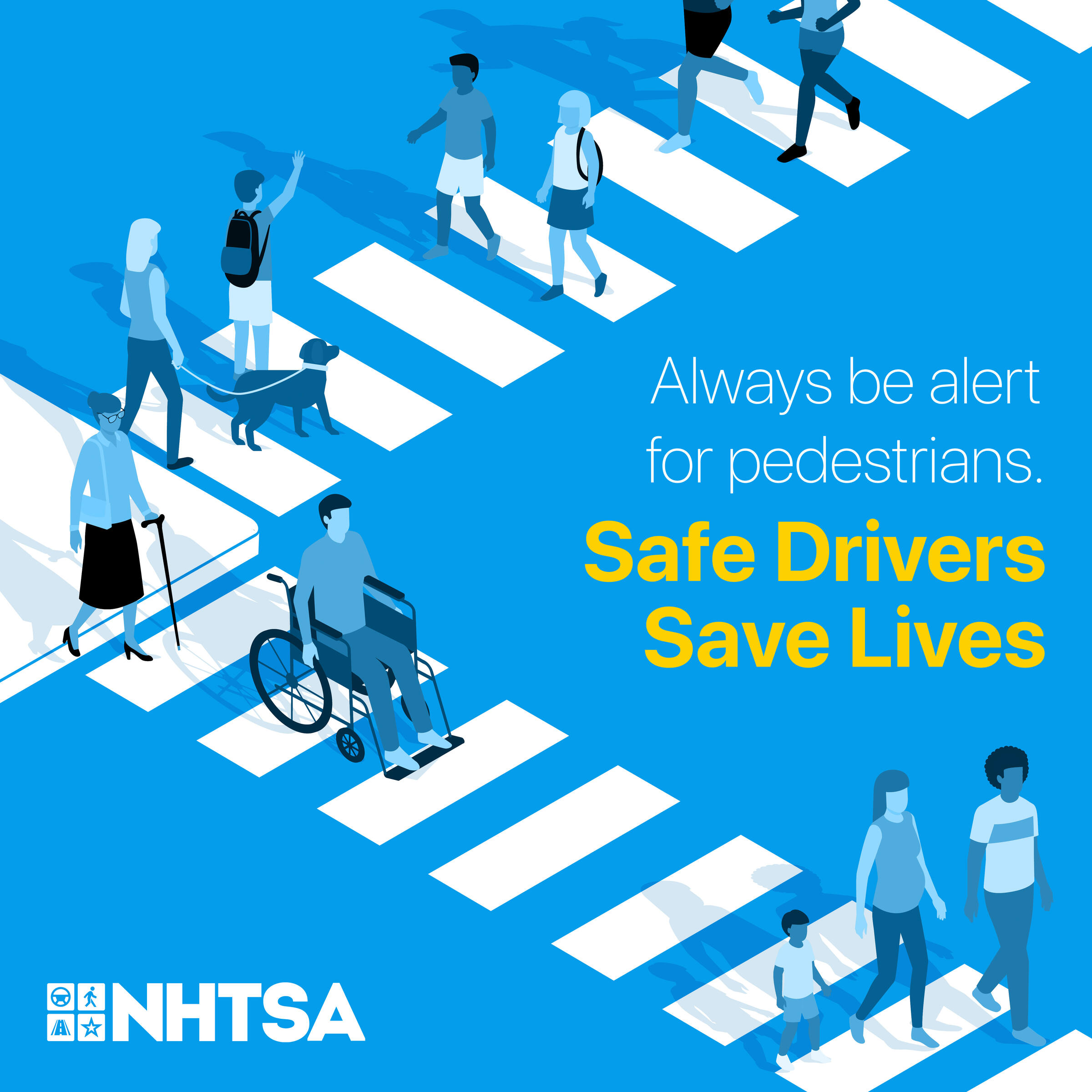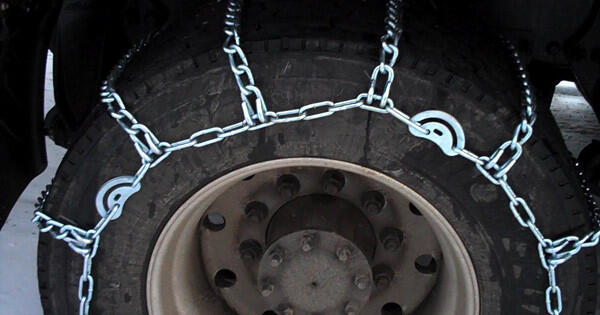Pedestrians & Commercial Motor Vehicles
Communicating with other Drivers and Pedestrians while Driving
By appropriately using communication, you make it easier for other drivers to see you. You also make it easier for you to see other drivers. Ensuring that you can see other drivers and that they can see you will drastically reduce the chance of an accident. The following communication devices are part of your "execution arsenal":
• Turn signals inform drivers that you are turning, changing lanes, pulling out of a parking space, or pulling out from the curb. You should signal at least four seconds before you plan to take action.
• Emergency Signals warn other drivers that you are experiencing vehicle trouble or when you must park on the shoulder of the roadway for an emergency. Emergency signals communicate to other drivers to give you more space.
• The horn should be lightly tapped when trying to gain the attention of another driver or pedestrian. Do not vent your frustrations by aggressively using your vehicle's horn.
• Headlights: Many new trucks have daytime running lights that turn on automatically. These help other drivers see you. You can flash your lights to oncoming traffic to warn them of dangers up ahead, such as accidents or obstructions in the roadway.

Turn Signals
Turn signals indicate your intent to change lanes, visually scan for adjacent traffic and road hazards, and then execute a safe lane change. By signaling your intentions well in advance, you will be in a safer position to communicate with the surrounding drivers.
A good safety practice is to signal at least 4 seconds before turning.
Did You Know? A recent study reported approximately 630,000 lane-change crashes annually (including large trucks and passenger vehicles).
While you certainly wouldn't know it from watching most drivers out there, using a turn signal to indicate a lane change is generally the law.
Emergency Signals (4 Ways)
FMCSA 392.22 Emergency signals; stopped commercial motor vehicles.
Whenever a commercial motor vehicle is stopped upon the traveled portion of a highway or the shoulder of a road for any cause other than necessary traffic stops, the driver of the stopped commercial motor vehicle shall immediately activate the vehicular hazard warning signal flashers and continue the flashing until the driver has placed the warning devices required by CFR 395.22. The flashing signals shall be used when the warning devices are picked up for storage before the movement of the commercial motor vehicle. The flashing lights may be used at other times while a commercial motor vehicle is stopped in addition to, but not in place of, the warning devices required by this section.
Horn
The horn in a commercial vehicle is a safety device that can prevent an accident by sounding an alarm and communicating the presence of others on the road. There are instances where drivers have abused the use of a horn by startling and even angering others. Be responsible and mindful when using your horn.
What does the Federal Motor Carrier Safety Administration say about a horn?
CFR§393.81:
Every bus, truck, truck-tractor, and driven motor vehicle in driveaway-towaway operations shall be equipped with a horn and actuating elements, which shall be in such condition as to give an adequate and reliable warning signal.
§393.81 DOT Interpretations
Question 1: Do the FMCSRs specify what type of horn will be used on a CMV?
Guidance: No.
Question 2: Are there established criteria in the FMCSRs to determine the minimum sound level of horns on CMVs?
Guidance: No.
Can I drive my commercial motor vehicle if the horn is not operational?
Answer: NO
Answer: CFR§392.7
Equipment, inspection, and use.
No commercial motor vehicle shall be driven unless the driver is satisfied that the following parts and accessories are in good working order, nor shall any driver fail to use or make use of such parts and accessories when and as needed:
Service brakes, including trailer brake control, Parking (hand) brake., Steering mechanism, Lighting devices and reflectors, Tires, horns, Windshield wipers or wipers, Rear-vision mirrors or mirrors, and Coupling devices.
Headlights
Many companies now have trucks programmed to have low-beam headlights on whenever the engine runs. Many states have laws that now require headlights to be on any time that windshield wipers are in use. Both are good safety practices.
Are the headlights on your truck "fogged" or dirty?
Do you ensure your headlights, turn signals, and brake lights are clean during pre and post-trip inspections?
Per the National Institute for Traffic and Highway Safety, the number one reason for severe nighttime accidents and reduced driving safety is dim or cloudy and improperly lit headlights. If a headlight has ineffective or diminished light output, your nighttime driving safety is significantly at risk. According to a study by the University of Iowa, a 20 to 50% reduction in headlight output leads to a 90% increase in the possibility of an accident.
Dim it!
Is flashing high beams at cars illegal?
Someone told me that flashing your headlights at a vehicle in front of you, particularly if it is going slow in the fast lane, is a citable offense. Is this true?
Yes, in some states, that is true.
The main concern of flashing an oncoming motorist is that they may be temporarily blinded and may create blind spots for other motorists while operating their vehicles, thus creating a hazardous situation.
Be on the Look Out for a "Digital Dead Walker"
A study by the American Academy of Orthopaedic Surgeons (AAOS) was released and finds that more than three-quarters (78 percent) of U.S. adults believe that distracted walking is a "serious" issue; however, 74 percent of Americans say "other people" are usually or always walking while distracted, while only 29 percent say the same about themselves.
This sense of "it's not me, it's you" cuts across a range of distracted walking behaviors:
- 90 percent say they see walkers talking on the phone (and 37 percent admit doing so themselves)
- 88 percent are engaging in conversation (vs. 75 percent themselves)
- 88 percent are listening to music (vs. 34 percent themselves)
- 85 percent are using a smartphone (vs. 28 percent themselves)
- 64 percent are generally "zoning out" or not focused on walking (vs. 38 percent themselves)
Can we talk and walk at the same time?
One of the challenges in combatting distracted walking may be that Americans are overly confident in their ability to multitask. When asked why they walk distracted, 48 percent of respondents say "they just don't think about it," 28 percent feel "they can walk and do other things," and 22 percent "are busy and want to use their time productively."
Among distracted walking behaviors, 75 percent of respondents say they "usually/always" or "sometimes" have "active conversations" with another person they are walking with, making this the most common distracted walking behavior people admit to doing themselves.
Walk safely, especially during this busy holiday season
The AAOS also offers the following tips to help pedestrians stay injury-free when walking indoors and outdoors, especially during this busy holiday season:
- If you must use headphones or other electronic devices, maintain a volume where you can still hear traffic sounds and your surroundings.
- While you walk, focus on the people and the objects and obstacles in front of and around you.
- Don't jaywalk. Cross streets carefully, preferably at a traffic light, remaining aware of the pedestrian traffic flow and the cars and bikes in and near the road.
- Look up, not down, especially when stepping off or onto curbs or in the middle of major intersections and when walking or approaching stairs or escalators.
- Traffic can be hectic during the holidays—stay alert in malls and other parking lots and on and near streets, especially during the winter months when it gets dark earlier.
- If you need to talk to a child or the person next to you, make a phone call, text, or other action that could distract you from the goal of getting where you need to go safely, stop and do so away from the pedestrian traffic flow.
"The AAOS urges pedestrians to avoid musculoskeletal and other injuries by engaging with their surroundings—drivers, bikers, other walkers and obstacles." "Many of us simply need to force ourselves to set down our devices and focus on what's in front of and around us. This will ensure that we safely arrive at our destination during this busy holiday season and throughout the year."
More information on distracted walking can be found at OrthoInfo.org/DistractedPedestrians
DOT Clearinghouse Annual Query Deadline is January 1st!
The annual DOT Clearinghouse deadline is only a few weeks away, with annual queries for all DOT-regulated CDL drivers due by January 1, 2023. If you have not yet run a query on each CDL driver you employ, (including yourself if you are an owner operator) you must do so by this date.
Failure to run these annual queries could lead to fines of up to $2,500 per driver.
About the Annual Clearinghouse Query
Employers must run at least one Clearinghouse query on each of their CDL drivers annually. You have the option of running either a full or a limited query, but if a limited query shows that there is information on a driver’s record, you will be required to run a full query within 24 hours. Failure to do so will result in the driver being pulled from safety-sensitive functions until you are able to run the full query.
Here are the differences in the queries:
A limited query is performed annually on existing drivers. The limited query simply alerts a motor carrier whether the driver has information in the database. Drivers sign a general consent of the motor carrier's making that is outside of the clearinghouse. Motor carriers may ask drivers to sign a consent that will work for more than one year, provided the release has an end date.
If a current driver has data in the clearinghouse, the employer must request a full query, which includes detailed information on the violation and any completed steps in the return-to-duty process. Motor carriers must also perform a full query as a part of the pre-employment. process on new hires. Due to the sensitive nature of the full query, the driver must have a portal account to electronically provide authorization. As a result, all applicants need a portal account, while existing drivers would only need one if a full query is necessary. If a driver refuses to give permission to access his or her clearinghouse record (limited or full query), he or she cannot perform a safety-sensitive function such as driving.
For additional information on the FMCSA Drug and Alcohol Clearinghouse go to:
https://clearinghouse.fmcsa.dot.gov/

Got Chains?
If you are operating in state that require chains to be on board, make sure the chains are the correct size, properly secured, clean, and not broken as to be easily applied when necessary.
Not sure what your states chain laws are go to:
http://www.tirechainsrequired.com/laws.html
